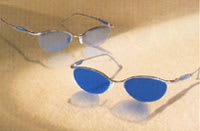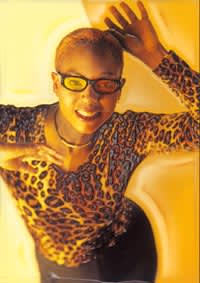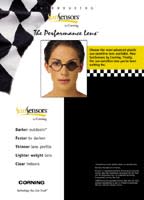
Photochromics... For Fun
or Function?
Recent product launches have resulted in
two distinct categories within photochromics. Here�s why.
By Joseph L. Bruneni
The original reason for a changeable lens was two-fold. The inventor�s primary motivation was to create a lens that would start out clear indoors and darken automatically to provide sun protection when wearers were out in the sun. If such a lens could be produced, it would hopefully replace the need for clip-ons or prescription sunglasses. A secondary concern was that such a lens would have the capacity to darken more on bright sunny days and less on overcast days.
Eventually, in the mid-�60s, Corning developed a glass that seemed to fill the bill. What made Corning�s new lenses so fascinating to consumers was that the lenses did something�they performed a function for wearers in a way that was highly visible. Eyewear consumers formed an attachment to photochromic lenses that has lasted up to the present day. Sadly, the launch of photochromic glass occurred at a time just as CR 39 lenses began to gain momentum. Within 20 years, plastic lenses had assumed the lion�s share of the lens market, but photochromics were only available in glass.
|
|
|
|
Solera Lenses by
InvictaVision come in several colors, and they are now
Rx-able.
|
|
The Advent of Photochromic Plastic
As glass lens wearers began converting to plastic, many wanted the kind of changeable lenses they had enjoyed with their glass lenses. They had to wait until 1991 before a viable photochromic plastic lens became available. The new Transitions photochromic plastic lenses were promoted as a �comfort� lens in a wise move to emphasize that they weren�t intended to be a true sunlens.
To provide a true sunglass, different photochromic formulations were created in both glass and plastic that would function as dark sunglasses. The nature of photochromic chemistry required that photochromic lenses that functioned as true sun lenses outdoors (15-25 percent transmission) would not completely lighten indoors, whether they were glass or plastic. Consumers today understand the way photochromic lenses work, and this high-end category of lens has earned a permanent place in the dispenser�s armament.
Here's a look at the choices dispensers currently have in plastic photochromic products to build that armament. In addition to basic Transitions lenses, produced by a number of major lens producers, several companies offer proprietary variations of the Transitions technology. Younger and X-Cel produce Quantum� photochromic lenses, a faster and darker photochromic adapted specifically to polycarbonate and high index plastic. Sola produces a faster, darker version of Transitions formulated to its Spectralite� mid-index substrate.
Corning's SunSensor� lenses are now produced by Signet Armorlite, Polyvision, and Vision-Ease. Rodenstock has its ColorMatic Extra lenses, and Optical Dynamics has even developed a special photochromic version for its in-office lens casting system. Add in Splitz� and Fanz� lenses from Transitions and Invicta's new Solera lenses, and you have a broad grouping of lenses offering a variety of photochromics with something�be it fun or function�for everyone.
|
|
|
|
Above:
Transitions� Splitz Lenses change from one color
outdoors to a different color indoors. |
In terms of glass, Corning added a new dimension to its photochromic glass a few years ago when it developed CPF Glare Control�. These photochromic glass lenses were created to provide added relief for people suffering from various degrees of light sensitivity. In these cases, the lens photosensitivity offers the patient a variable control that provides added protection when outdoors.
Regardless of use, consumers in North America prefer gray sunlenses, while brown is the preferred color in Europe. To satisfy worldwide demand, most photochromic lenses are now produced in both gray and brown.
Another factor influencing photochromics has been the trend toward materials with a higher refractive index than glass or CR 39. As a result, some new photochromics have been developed that have higher indices, mostly in the mid-index range (1.54 to 1.57).
An Age Problem
Market surveys indicate that at least one-third of eyeglass wearers would be interested in wearing photochromic lenses, yet, currently, fewer than half that number are wearing them.
Surveys conducted to determine why found that the percentage of young people wearing photochromic lenses was considerably less than that age group�s representation in the general population. They also found that contact lens wearers, who tend to be younger, were not taking advantage of photochromics.
These marketing gurus knew, of course, that photochromics are more expensive than conventional lenses, and focus groups seemed to confirm that price was one of the issues keeping young people from ordering photochromics. Yet blaming it all on price didn�t seem to make sense when they looked at the athletic shoe market, where young people flock to the colorful, fashionable, and expensive status symbol shoes. Why? They represent fashion and fun to young people. Could there be a lesson in this for lens manufacturers?
|
|
|
|
Rodenstock�s ColorMatic
Extra Lenses are plastic, not glass.
|
|
Fun Photochromics
The answer is yes. Recognition of the need to develop fashionable, fun photochromic lenses led directly to the recent development of a totally new category of photochromic lens�fun lenses with fashion colors that not only darken in the sun but change color as well.
There is another interesting aspect to this new lens category. Ten years ago fashion tints were a common component of eyewear fashions. The majority of lenses dispensed at that time were fashion tinted�solid tints and gradient tints. That popularity of cosmetic fashion tints faded in recent years to the point where today more clear lenses are dispensed than with fashion tints.
Fickle Fashions
Constant change is, in fact, a hallmark of fashion, and this happened to fashion tints for lenses. If, however, color (fashion) could be harnessed to function (photochromic), perhaps a new fashion trend could be launched. That�s exactly what now seems to be taking place with ophthalmic lenses.
Several companies have recently launched variations of photochromic lenses that fall specifically into the category of fun and fashion. Here�s a run-down on how each of these new lenses functions, and how they vary from one another.
Transitions� FunLenses. The company that created the initial photochromic plastic has created a new line of multi-colored photochromic products it calls FunLenses, consisting of two divisions. One division is Splitz�, representing lenses that change from a fashion tint indoors to a darker and different color outdoors. The outdoor color varies, depending on the sunlight conditions and the temperature. Splitz lenses are offered in three variations:
-
Rose indoors changing to purple outdoors
-
Yellow indoors changing to orange outdoors
-
Blue indoors changing to green outdoors
|
|
|
|
SunSensors
by Corning provide quick darkening in a light, plastic
lens. |
Splitz lenses are available in single vision Rx form and in plano form. The lenses are being promoted through laboratories to the eyecare professions and launched in plano sunglass form through participating retail stores.
The second part of FunLenses, though not currently being actively promoted, is called Fanz�. The first variable tint Fanz sunglasses are being produced for football fans of Florida State University, enabling them to show their team �colors� with their FANZ sunglasses. These have lenses that change color from gold to garnet depending on sunlight conditions and temperature. Transitions is also offering the Fanz line to other teams and has signed a licensing agreement with the Cleveland Browns. Those FANZ variable tint sunglasses will feature the Browns� colors�orange to brown.
Solera Lenses. The newest entry into fun photochromics are Invicta Vision�s Solera Fashion Photochromic Lenses. This new company has tackled the subject of fashion colors and photochromics head on. The company developed a patented process to produce a wide variety of colors it believed were both fashionable and functional. Solera lenses are now produced in eight colors�blue, teal, rose, yellow, orange, plum, brown, and gray.
Solera lenses differ from the technology used for Splitz in that each fashion tint changes in the sun to a darker shade of the indoor color. Yellow lenses darken to dark yellow, etc.
Solera lenses are being released at International Vision Expo East in New York in prescription form for the optical trade. The company believes their unique fashion lenses will also find a large market in the plano sunglass field because of the ability to match and contrast frame colors with lens colors.
Photochromic lenses have become important because they offer real benefits and are one of the highest ticket items in eyewear. As a result, you can expect to see continuing developments in both aspects of photochromics�fun and function. Teach your staff how to build business in both. EB
|
Internet Resources |
|
|
Need additional information on photochromic products? Here�s how: Corning Photochromic glass & GlareControl� lenses: www.optical.corning.com Corning Sunsensor lenses: www.corning.com/sunsensors Optical Dynamics photochromic lenses: www.opticaldynamics.com Rodenstock ColorMatic Extra lenses: www.rodenstockusa.com Sola�s Velocity lenses: www.sola.com Solera lenses: www.invictacorp.com Transitions lenses: www.transitions.com Transitions Splitz lenses: www.transitions.com/funlenzes/ |
|







